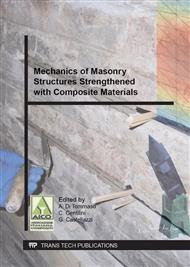p.106
p.114
p.123
p.131
p.139
p.147
p.155
p.163
p.170
Monitoring of Masonry Compression Tests in the Lab via Optical Correlation without Surface Preparation
Abstract:
Digital image correlation (DIC) is a recently developed optical technique allowing high-definition maps of displacements and deformations of the element under view. Various fields of application are already known where thermal and mechanic distorsions of the object have been explored by comparing false-colour images recorded in different deformation states. The method is becoming more common in civil engineering where first applications were limited to metal structural elements and composite material reinforcements [1-3]. The main advantages of this optical technique lie in contact-free, full-field measurements. In order to enhance the displacement spatial resolution, one of the recognised requirements of the method – in fact, so far, unavoidable – is the preparation of the investigated surface by applying a thin, white mat coating followed by a distribution of speckles (black dots) of appropriate sizes. This preliminary procedure constitutes a disadvantage of DIC due to the necessary preparation time and to inappropriateness of the requirement in case of testing high-value objects such as cultural heritage [4]. In this work, an innovative experience of DIC is presented for a case of mechanical test monitoring of brick masonry, in the lab (specimen dimensions: 0.50x0.5x0.12 m3). In addition, no coating of the surface of interest has taken place. The attempt is to validate the applicability and reliability of the method for this composite material when the masonry materials’ texture is exploited as the reference pattern to monitor geometry variations of the specimen under increased load levels. A further challenge of the experiment was due to the visible degradation state of the masonry specimen, which prior to the destructive compression load test had undergone accelerated ageing through cycles of salt crystallization and consequent discolouring and partial skin loss. The aims were to obtain from DIC high-definition full-field information able to reliably replace traditional measurement instruments such LVDTs, extensometers or TML gauges, determining instead 3D in-plane and out-of-plane displacements, tensions and strains at different load levels up to specimen collapse. The outcome of the experiment provided a better understanding of the masonry behaviour under axial load and of the local and global distribution of the above mentioned characteristic mechanical parameters together proving the reliability of the DIC technique under the specific monitoring constraints.
Info:
Periodical:
Pages:
139-146
Citation:
Online since:
September 2014
Authors:
Keywords:
Price:
Сopyright:
© 2015 Trans Tech Publications Ltd. All Rights Reserved
Share:
Citation:


